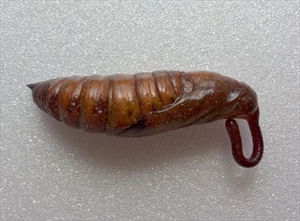- Widespread distribution. Asia, Africa, Europe, Oceania. Sweetpotato main host, but it also occurs on eggplant, capsicum, tomato, and legumes. Occasionally, an important pest.
- Larvae eat young succulent leaves. Eggs are laid singly on the leaves and stems. Outbreaks are not common, although they are devastating when they occur.
- Natural enemies: parasitoid wasps and predators.
- Cultural control: avoid planting next to gardens where outbreaks have occurred; handpicking; use chickens; collect vines and other trash and burn after harvest.
- Chemical control: none recommended for routine treatments, as pesticides will disrupt natural control. For major outbreaks: PDPs: neem, derris, pyrethrum, or chilli; or biopesticides – Bt (Bacillus thuringiensis), or spinosad. Synthetic pyrethroids are likely to kill natural enemies.







